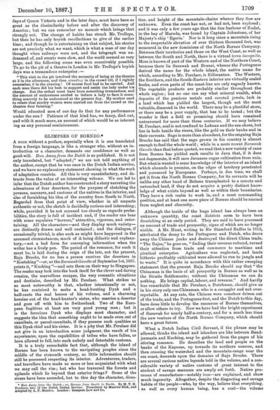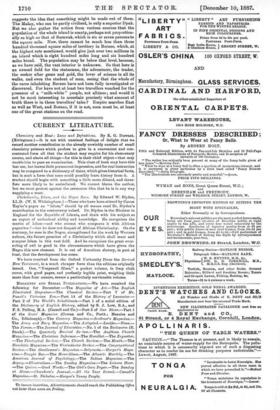GLIMPSES OF BORNEO.*
A BOOK without a preface, especially when it is one translated from a foreign language, is like a stranger who, without an in- troduction or a character, demands our confidence as well as good-will. Run Away from the Dutch is so published. It is not only translated, but " adapted ;" we are not told anything of the author, except that he was once in the Dutch Indian service, and we have no explanatory statement showing in what the work of adaptation consists. All this is very unsatisfactory, and de- tracts from the value of an interesting volume. We are led to infer that the Dutch author has constructed a story narrating the adventures of four deserters, for the purpose of sketching the persons, manners, and customs of the natives in the interior, and also of furnishing his idea of the country from South to North. Regarded from that point of view, whether in all respects authentic or not, the sketch is decidedly curious and interesting; while, provided it be not scanned too closely as regards proba- bilities, the story is fall of incident and, if the reader can bear with some repulsive "horrors," attractive, vigorous, and enter- taining. All the characters—and they display much variety— are distinctly drawn and well sustained ; and the dialogue, if occasionally trivial, is also such as might have happened in the assumed circumstances, much of it being didactic and explana- tory,—not a bad form for conveying information when the writer has a lively pen. The period of the romance, for such it must be, is laid during the reign of the late, not the present, Raja Brooke, for no lees a person receives the deserters in "Koetshing"—or, as the Sarawak Gazette of September 1st, 1887, prints it, "Kuching "—and sets them on their way to Singapore. The reader may look into the book itself for the clever and daring evasion, the marvellous escapes, the very romantic situations and destinies, described by Mr. Perelaer. What strikes us as most noteworthy is that, whether intentionally or not, he has contrived to make a head-hunting Dyak and a half-caste the real heroes of his volume, and a charming heroine out of the head-hunter's sister, who marries a deserter and goes off with him to Switzerland. Two of the Euro- pean fugitives at least are very good young men ; but it is the ferocious Dyak who displays most character, and suggests the idea that something ought to be made even out of cannibals, or parcel.cannibals, if they possess such qualities as this Dyak chief and his sister. It is a pity that Mr. Perelaer did not give in an introduction some judgment, the result of his experiences, upon the capabilities of tribes who have fallen, or been allowed to fall, into such unholy and detestable customs.
It is a truly remarkable fact that, although the island of Borneo has been known to the navigating peoples since the middle of the sixteenth century, no little information should still be possessed respecting its interior. Adventurers, traders, and travellers have made us more or less acquainted with what we may call the rim ; but who has traversed the forests and uplands which lie beyond that exterior fringe P Some of the rivers have been ascended, but to this day the character, dire°.
• Bun Away from the Dutch; or, Borneo from South to North. By M. T. H. Penises% late of the Dutch Indian Service. Translated by Maurice Blob, and Adapted by A. P. Mendes. London: Sampson Love and Co. tion, and height of the mountain-chains whence they flow are unknown. Even the coast has not, or had not, been explored ; and it was only a few years ago that the fine harbour of Kudat, in the bay of Marna, was found by Captain Johnstone, of her Majesty's ship Egeria.' Nor is it long since a mountain rising to the respectable elevation of over thirteen thousand feet, was measured in the new dominions of the North Borneo Company. Between their territories and those on the West Gaut, as well as between the South and North, there is a virtual terra incognita. More is known of part of the Western and of the Northern Coast, because there lie Sarawak and Brunei, whence the Portuguese derived the name for the whole island, the native name for which, according to Mr. Perelaer, is Kilimantan. The Western, the Southern, and the South-Eastern interior are virtually sealed books, and even parts of the coast-line are only vaguely known. The vegetable products are probably similar throughout the whole region ; but no one can say what mineral wealth, what deposits of the precious metals and coveted jewels, lurk in a land which has yielded the largest, though not the most valuable, diamond in the world. There may be a plentiful store, or there may be a poor supply, that has to be tested ; but the wonder is that a field so promising should have remained nntraversed for more than three centuries. If we may believe M. Perelaer, coal is not confined to Lalman and the sea-shore, but lies in beds beside the rivers, like the gold on their banks and in their currents. Sago is more than abundant, for the reigning Raja Brooke has said that the sago grown in his country is almost enough to feed the whole world ; while in a more recent Sarawak Gazette than that before quoted, we read that anew variety of cane from Borneo has yielded each results in Java that, if it does not degenerate, it will save Javanese sugar cultivation from ruin. But what is wanted is some knowledge of the interior of an island which abounds in promise, on the edges of territory penetrated and possessed by Europeans. Perhaps, in due time, we shall get it from the North Borneo Company, for its servants will be unlike any other band of Britons transplanted to a remote and untouched land, if they do not acquire a pretty distinct know- ledge of what exists beyond as well as within their boundaries. They have a rich realm to work in, and a most commanding position, and at least one more piece of Borneo should be rescued from neglect and obscurity.
Although the inside of the huge island has always been an unknown quantity, the coast districts seem to have been flourishing at an early period. They are said to have possessed an amount of trade and prosperity, signs of which are no longer visible. A Mr. Hunt, writing to Sir Stamford Raffles in 1812, attributed the decay to the Portuguese and Dutch, who drove away the Chinese junks and destroyed the direct China trade. "The Rajas," he goes on, "finding their revenue reduced, turned their attention from trade and commerce to maritime and piratical enterprise. Agriculture was neglected, and lands hitherto profitably cultivated were allowed to run to jungle and to waste." It is quite in accordance with this rather sweeping statement that the present Raja Brooke should say that "the Chinaman is the basis of all prosperity in Borneo as well as in the Straits Settlements ; without the Chinaman we can do nothing. He brings capital, labour, and revenue." And hardly less remarkable that Mr. Perelaer, a Dutchman, should give us in his story only one Chinaman, who is a smuggler and not over- reputable. At any rate, the Chinese were somehow driven out of the trade, and the Portuguese first, and the Dutch to this day, have done little to develop the resources of Borneo themselves, or allow others to try. Now we have had the bright experiment of Sarawak for nearly half-a-century, and for a much less time the new venture of the North Borneo Company, which should have a great future.
What a Dutch Indian Civil Servant, if the phrase may be allowed, thinks the island and islanders are like between Band. jermasin and Kuching, may be gathered from the pages of his stirring romance. He describes the land and people on the banks of the Kapoeas, up towards its northern sources, and then crossing the watershed and the mountain-range near the sea coast, descends upon the domains of Raja Brooke. There are several curious native legends told in the volume, and a con- siderable variety of native customs of great interest to the student of savage manners are amply set forth. Native pro- ceases of manufacture—notably iron—are explained, and show much ingenuity. Altogether, despite the disgusting and savage habits of the people—who, by the way, believe that everything, as well as every human being, has a soul—the volume suggests the idea that something might be made out of them. The Malay, who can be partly civilised, is only a superior Dyak. But we also gather the notion from various sources that the population of the whole island is scanty, perhaps not proportion- ally so high as that of Sarawak, which is six or seven persons to the square mile. Now, there cannot be mush less than three hundred thousand square miles of territory in Borneo, which, at the highest rate mentioned, would give just over two millions in an island which is eight hundred miles long and six hundred miles broad. The population may be below that level, because, as we have said, the vast interior is unknown. So that here is an unused field for the statesman, the adventurer, the trader, the seeker after gems and gold, the lover of science in all its walks, and even the student of man, seeing that the whole of the races inhabiting Borneo have not been fully investigated or discovered. For have not at least two travellers vouched for the presence of a " milk-white " people, not albinos ; and would it not be most interesting to ascertain precisely what amount of truth there is in these travellers' tales P Empire marches East as well as West, and Borneo, if it is not, soon must be, at least one of the great stations on the road.























































 Previous page
Previous page